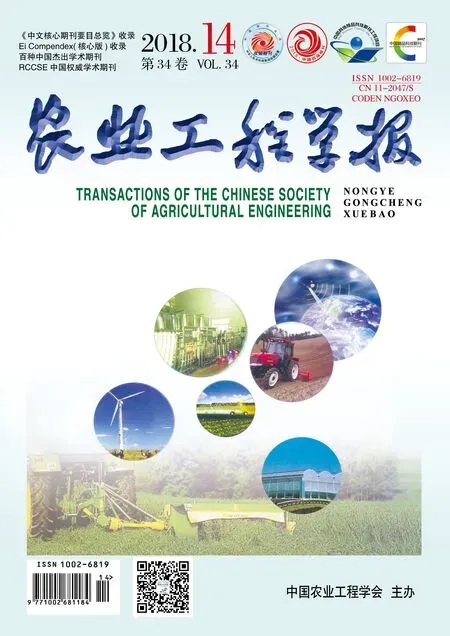饱和修正系数提高ZZLAS型闪烁仪测量显热通量精度
2018-08-10张劲松施生锦黄彬香
张 功,张劲松※,施生锦,孟 平,黄彬香,郑 宁
饱和修正系数提高ZZLAS型闪烁仪测量显热通量精度
张 功1,2,3,张劲松1,2,3※,施生锦4,孟 平1,2,3,黄彬香4,郑 宁1,2,3
(1. 中国林业科学研究院林业研究所,北京 100091;2. 国家林业局林木培育重点实验室,北京 100091;3. 南京林业大学南方现代林业协同创新中心,南京 210037;4. 中国农业大学资源与环境学院,北京 100093)
为了研究饱和效应对大孔径闪烁仪估算区域显热通量的影响,在2014年8—9月期间进行试验,以具有抗饱和性能的双光路BLS900型闪烁仪为参考,以孔径尺寸为0.075 m(文中简记为LAS1)、0.15 m(文中简记为LAS2)的中国产ZZLAS型闪烁仪为研究对象,通过光学传播原理计算出饱和修正系数,并对ZZLAS型闪烁仪的观测结果进行饱和修正分析。结果表明:LAS1的饱和修正系数为1.034,LAS2的饱和修正系数为1.019。试验观测中LAS1饱和率为24.58%,LAS2饱和率为2.04%,进行饱和修正后,LAS1的有效饱和修正率为12.87%。与BLS900相比,LAS1修正后显热通量均方根误差变为25.67 W/m2;LAS2的饱和修正率仅为0.32%,修正前后显热通量均方根误差基本无变化。进行饱和修正前,对BLS900与LAS1观测的显热通量进行检验,未达到显著水平(0.15);通过计算得出的修正系数修正后,达到极显著水平(0.004);而利用BLS900的实时修正系数进行修正后,接近显著水平(0.06)。利用试验计算得出的饱和修正系数修正后,显热通量与参考标准的误差范围为1.28~53.42 W/m2,比修正前更接近BLS900的观测结果。研究对农田、人工林下垫面条件下的观测结果采用文中的饱和修正方法进行验证,结果也表明,经饱和修正后,闪烁仪观测的显热通量更接近BLS900的观测结果。当ZZLAS型闪烁仪发生明显饱和现象时,利用光学传播原理计算得出的修正系数对饱和数据进行修正效果显著。
蒸散;仪器误差;饱和;区域尺度;孔径平均效应;饱和修正
0 引 言
显热通量是能量平衡的重要组成部分,表征着下垫面与大气间的相互作用,是地气交互过程中重要的参数[1]。因此一直是农林、生态、水文、气象等领域研究的重点内容。传统观测方法,如能量平衡法、空气动力学法、涡动相关法等,这些方法对研究地表能量交换及水资源合理利用与管理等起到了非常重要的作用[2],但研究尺度均为单点尺度(百米级)。随着遥感技术的发展,以及水文模型、陆面过程模型、数值天气预报等对大尺度(千米级)水热通量测算结果的需求,如何获得大尺度通量的精确测算结果已成为模型算法发展的制约因子[3-4],同时由于实际农业生产的需要,区域范围内的水热通量研究也变得尤为重要[5-7]。近年来,大孔径闪烁仪(large aperture scintillometer,LAS)因其能够同时获得时间和空间上的平均显热通量而被广泛使用。根据孔径尺寸的不同,有效观测距离可扩展至5或10 km, 测量尺度与遥感像元尺度匹配较好,更适用于复杂多变的下垫面,并在观测试验中得到了大量应用[8-10]。中国产ZZLAS型闪烁仪测量结果准确,操作简单,性价比高,因而在国内的应用越来越普遍[8-9,11]。
国内外关于闪烁仪饱和效应的研究较少,而关于ZZLAS型闪烁仪的饱和研究更是缺乏公开发表的文献可供参考。大多数国内学者利用闪烁仪进行观测研究时,仅根据Ochs给出的饱和界限进行数据剔除,并未进行饱和修正,这种数据处理方式既降低闪烁仪观测的有效数据量也影响观测精度。因此,本文在通过试验观测得出的ZZLAS型闪烁仪饱和界限的基础上[12],基于光学传播原理的修正方法,对ZZLAS型闪烁仪的饱和数据进行饱和修正研究,旨在提高ZZLAS型闪烁仪的测量精度,从而进一步实现精确估算蒸散,为深入研究能量平衡、水分平衡在气候变化研究中提供更加准确的数据。
1 数据来源和研究方法
1.1 数据来源
研究中所使用的闪烁仪饱和数据均为实测数据。试验主要在河北省张家口市坝上地区的沽源县草地生态系统国家野外试验站(41°46¢06²N,115°40¢50²E)进行,试验选择孔径为0.075 m(本文简记为LAS1)和0.15 m(本文简记为LAS2)2套闪烁仪进行试验。由于BLS900型闪烁仪(Scintec,德国)采用双光路进行工作,抗饱和性能较强,且系统自身的数据处理单元(signal processing unit,SPU)可以实现数据的实时修正[19-20],因而将之作为本试验的参考标准。
试验观测时间为2014年8月28日至2014年9月16日。试验期间气温较低,风大,降雨频繁,伴有结露霜冻天气。试验场地下垫面平坦,植被平均高度约10 cm,闪烁仪的发射端和接收端的安装平台均为三脚支架。为避免太阳辐射的影响,闪烁仪安装呈东南—西北方向。为避免信号交叉的影响,采取相邻两套闪烁仪的发射端和接收端交叉安装方式,即LAS1的发射端与LAS2的接收端相邻,LAS1的接收端与LAS2的发射端相邻。仪器布置如图1所示,安装参数见表1所示。试验中所用数据采集器为CR1000(Campbell Inc. 美国),采样频率为1 Hz。
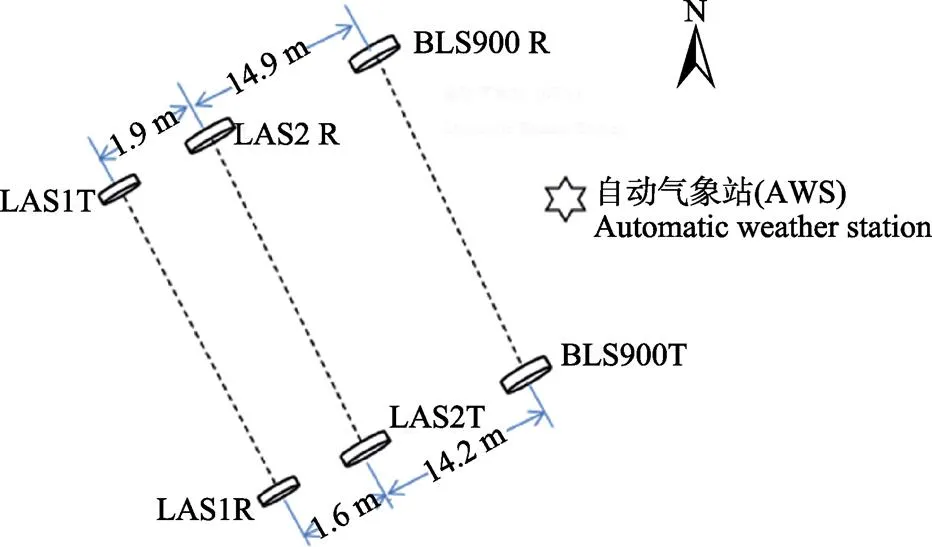
注:LAS1,LAS2,BLS900的发射端分别表示为LAS1T,LAS2T,BLS900T;LAS1,LAS2,BLS900的接收端分别表示为LAS1R,LAS2R,BLS900R。下同。

表1 试验仪器安装信息
根据自动气象站观测的雨量数据以及空气湿度数据,剔除降雨时刻以及相对湿度大于95%的数据。剔除信号大于–50 mV的信号数据,剔除BLS900闪烁仪因供电不足、观测信号低所导致的长时间序列中的无效数据,同时根据BLS900输出的信号诊断文件进行数据质量控制,剔除不符合观测要求的数据。根据试验结果[11]获得的ZZLAS型闪烁仪的“强饱和”界限0.359,剔除强饱和数据;选出观测数据位于“弱饱和”界限0.099和“强饱和”界限0.359间的数据进行修正。计算得出,LAS1的强饱和阈值为7.910×10–13m–2/3,弱饱和阈值为3.779×10–13m–2/3;LAS2的强饱和阈值为4.598× 10–12m–2/3,弱饱和阈值为1.180×10–12m–2/3。试验中依据0.193–8/31/35/3对BLS900进行的饱和判定。试验中达到“弱饱和”界限的数据量占观测数据总量的比值定义为饱和率。进行饱和数据修正后,数值变化大于10%的修正被定义为有效修正,有效修正的总数占饱和数据总量的百分数称为有效饱和修正率。试验中LAS1的饱和率为24.58%,LAS2饱和率为2.04%,而BLS900的饱和率仅为0.13%,无明显饱和现象。研究中主要针对LAS1和LAS2位于强饱和界限和弱饱和界限间的数据进行修正。经数据质量控制后,沽源试验总体有效数据样本量=12097。
1.2 研究理论与方法


式中是光波数(=2π/),为波长,是路径长度,是路径归一化函数,表示路径上距离发射端的位置与总长度的比值,()是折射谱函数,是一维空间波数。最常用的谱函数是Kolmogorov函数[17],即

将式(2)代入式(1)可得到下述方程









1.3 显热通量的计算


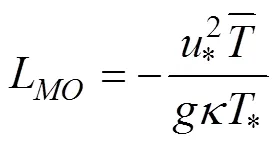


2 结果分析
2.1 饱和修正系数的计算
计算得出的BLS900、LAS1、LAS2饱和修正系数分别为1.014、1.034、1.019。使用这些参数时需要注意的是,闪烁仪饱和现象的发生主要与观测高度与光束路径长度有关,且受观测区域的气象条件(温度、湿度等)影响较大,因此本文计算得出的饱和修正参数更适用于本研究或与研究相似观测条件。
LAS1的饱和修正系数最大,BLS900与LAS2的饱和修正系数相对较小。闪烁仪的孔径尺寸不同,其发生的饱和现象程度也各不相同[11,19]。根据参数b可知,结合孔径平均效应可知,LAS1发生饱和现象与内尺度0的关系最密切,而相同的内尺度0对BLS900与LAS2的饱和现象影响较小。这种差异的原因是因为孔径尺寸的不同,在本试验安装条件中,对闪烁仪的测量贡献最大的菲涅尔尺度大小约为24 mm,较小孔径尺寸的LAS1在强烈湍流状态下更容易发生饱和现象,而较大孔径尺寸的BLS900与LAS2由于孔径平均效应的存在,受到内尺度0的影响较小。
2.2 空气折射指数的修正前后比较
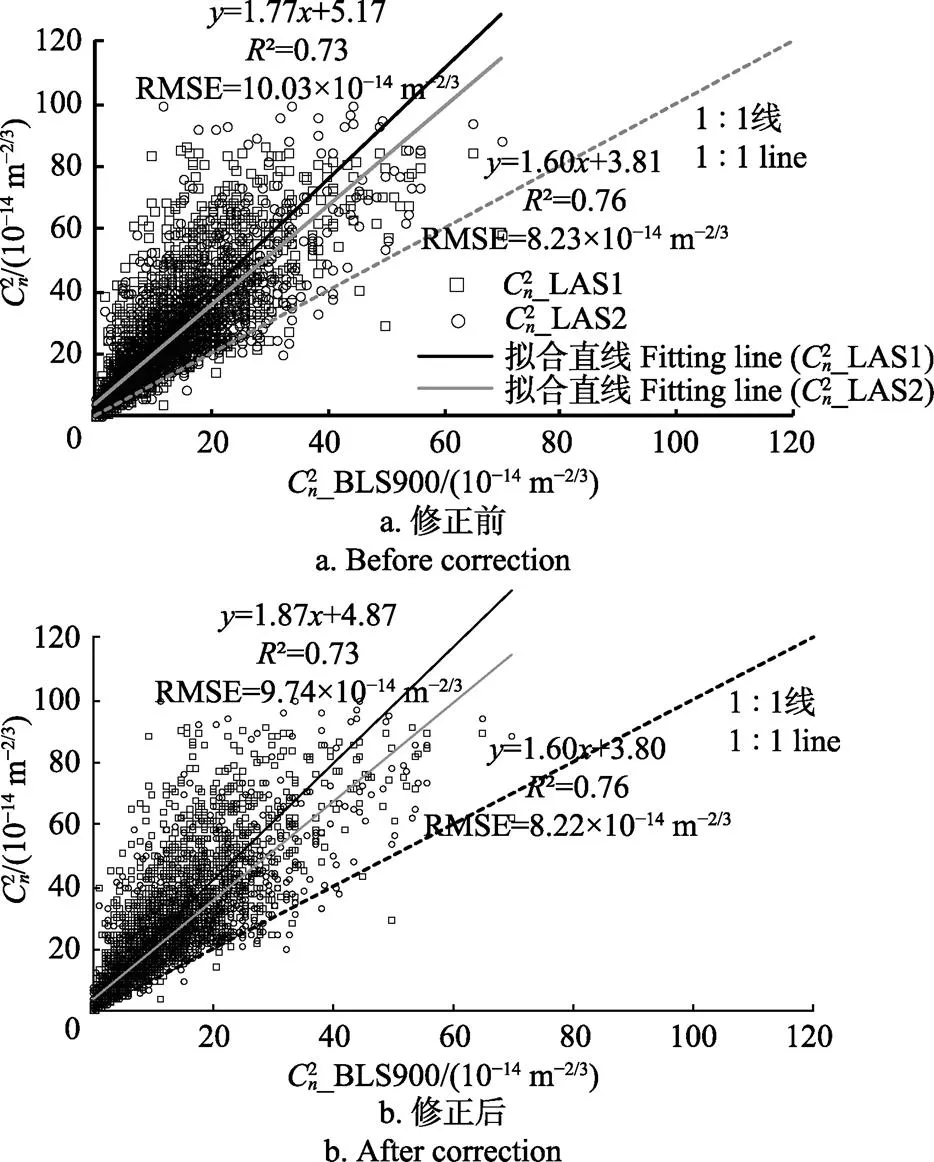
图2 LAS1、LAS2与BLS900观测的空气折射指数Cn2在修正前后的比较
2.3 BLS900实时修正系数与计算的修正系数比较


注:除BLS900实时修正系数外,其他曲线均对应于左边的纵轴。

2.4 饱和修正对通量结果的影响
饱和修正对显热通量()的影响见图5所示。可知,采用试验得出的修正系数对数据进行饱和修正后LAS1与BLS900的斜率由0.94变为0.97,RMSE由36.67 W/m2变为25.67 W/m2;而利用BLS900的实时修正系数修正后,显热通量线性关系变化不明显,且RMSE变化幅度仅为0.83 W/m2。由图5a可以看出,当显热通量达到50 W/m2时,修正后的通量值离散性减小,且修正值多位于1∶1线的下方,随着通量值的增大,数据的离散性越小,而用BLS900实时修正系数进行修正时,位于1∶1线的上方区域的显热通量变化更加明显(图5b),这会造成合理的通量值发生低估现象。显热通量达到120 W/m2时修正效果才开始明显。对显热通量修正前后进行-检验结果显示,修正前BLS900与LAS1观测的显热通量0.15(>0.05),二者表现出较大的差异,显著性并不明显。按图5a的修正方法后,二者的=0.004(<0.01),达到极显著水平;按图5b方法进行修正后=0.06(>0.05),达到显著水平。这2种不同修正方式出现差异主要是因为实时修正在整体上对观测数据进行修正,未饱和的数据与饱和数据均被进行同时修正,几乎全部观测数据参与修正,结果导致未饱和数据偏小,饱和数据变大,整体通量根据数据饱和率出现不同程度的降低或增加。

图4 LAS1、LAS2观测的Cn2用BLS900实时修正系数修正后与BLS900观测的Cn2对比
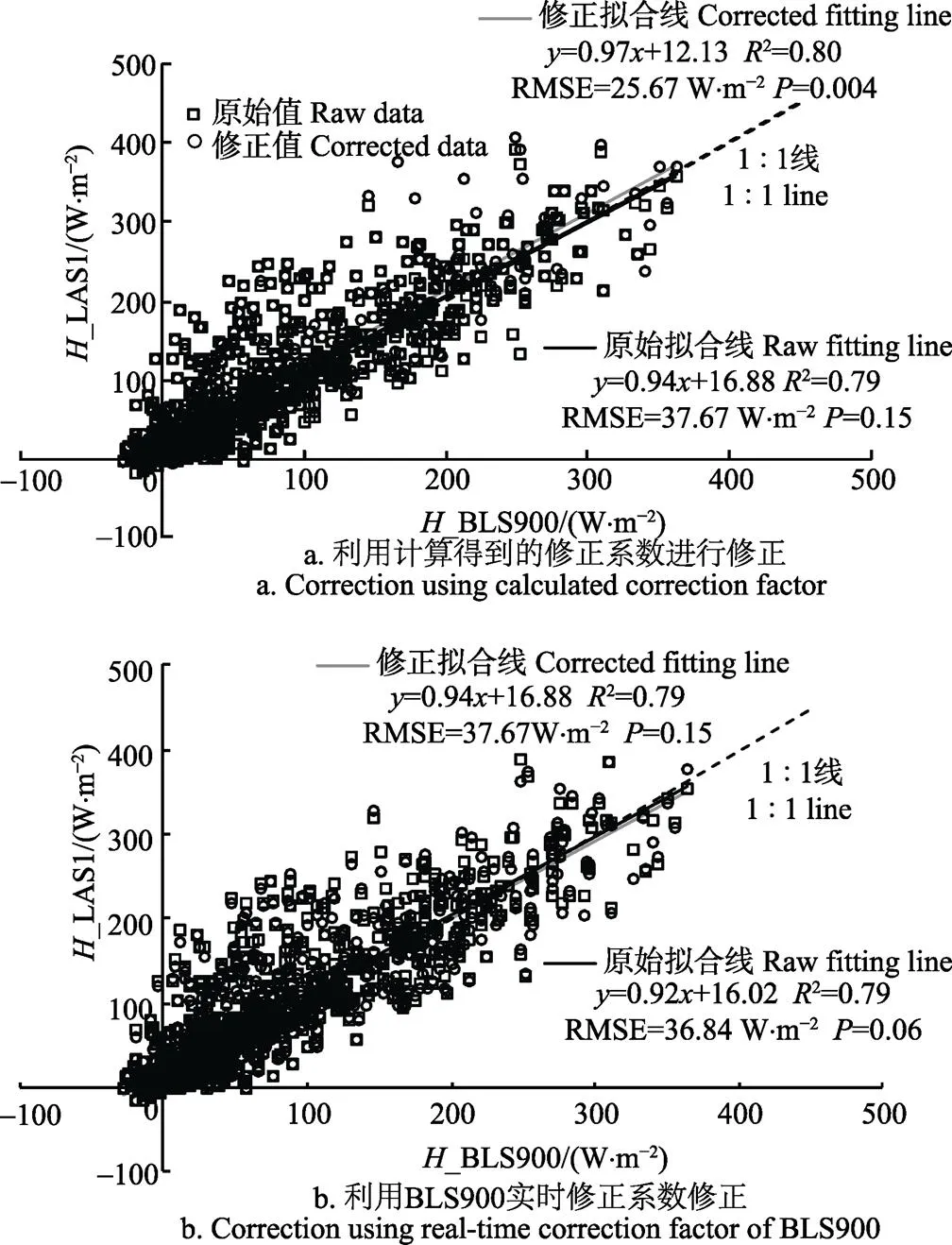
图5 LAS1饱和修正前后显热通量(H)的对比


注:选择2014年9月5日11:00—15:00数据,显热通量时间间隔10 min。
2.5 数据验证
本研究提出的饱和修正方法已在沽源试验(本文)中得以验证,沽源试验地区地势平坦,植被均一,下垫面热力属性差异不明显。为了验证本研究所用方法在其他下垫面条件下的适用性,本文对下垫面分别为农田、人工林的观测结果进行验证。观测仪器为LAS1和BLS900,其中BLS900仍作为参考标准。LAS1在农田下垫面条件下安装的有效高度3.8 m、路径长度864 m以及计算得出的饱和修正系数为1.042。 LAS1在人工林下垫面条件下安装的有效高度27.3 m、路径长度1 036 m以及计算得出的饱和修正系数为1.021。
与沽源试验不同,用于饱和修正方法验证的数据属于常规观测,饱和现象并不十分明显,为使验证结果清晰明了,验证的数据仅选择中午时分(11:00‒13:00)观测数据进行饱和修正处理,相应显热通量结果如图7所示。可知,LAS1的饱和数据经过饱和修正后更接近BLS900的观测结果。农田验证结果出现饱和修正后LAS1观测的显热通量仍然明显小于BLS900的观测结果(第3~5样本)。这种差异尚无确定解释。因为农田验证数据取自中国农业大学上庄试验站,试验观测期间农作物长势旺盛,灌溉、除草等人为影响较大。反观人工林验证数据经饱和修正后,LAS1观测的显热通量更接近BLS900的观测结果。人工林位于黄河小浪底地区,地形条件复杂,观测区域起伏不平,几乎没有人为活动的影响,因而饱和修正后的显热通量更能接近BLS900的观测结果。

注:农田验证数据选择2014年8月24‒29日11:00—13:00数据,人工林验证数据选择2016年7月16‒21日11:00—13:00数据。显热通量时间间隔30 min。
3 讨 论
闪烁仪准确的观测数据是进行千米级陆面蒸散研究的前提,而实际观测过程中闪烁仪的饱和现象不可避免。闪烁仪的饱和现象的发生主要与湍流强度有关,虽然“孔径平均效应”在一定程度上减缓了饱和现象的发生,但在安装过程中由于安装距离和高度的原因,湍流的迅速变化仍然会导致饱和现象的出现[19,23]。ZZLAS型闪烁仪在湍流强烈时容易发生饱和现象,湍流条件不强烈时饱和现象不明显,且饱和现象符合“孔径平均效应”规律,大多数饱和数据可以进行修正[11]。
闪烁仪在测量过程中其光强与测量区域固有的空气结构指数存在一定的关系,这个关系通常会受到湍流强度的影响[23],因此湍流对闪烁仪最直接的影响就是闪烁仪接收的信号强度。闪烁仪的信号强度与空气折射指数间的经验关系通常选择中性或近中性条件下的经验函数[28],当饱和现象发生时,湍流状态发生改变,经验函数也会随之改变。Hartogensis等[29-30]对湍流内尺度0进行研究表明,内尺度相差0.3 mm时会对最终显热通量结果产生0.5%的偏差,Kohsiek等[19]对闪烁仪进行饱和修正研究时发现,进行饱和修正处理后的显热通量会增加约50%,认为修正后的显热通量更接近真实值(与涡动相关法测量相比)。研究中ZZLAS型闪烁仪进行饱和修正后显热通量提高约3.5%,与Kohsiek等研究存在差异的原因可能与试验过程中的数据饱和程度有关,同时也受到修正方法的影响。
湍流中的内尺度0是引起闪烁仪饱和现象的关键因素[13-15],在进行饱和修正过程中必须考虑湍流内尺度0的影响才会使得修正结果更加准确。在针对ZZLAS型闪烁仪的饱和修正研究中,基于Hill和Clifford原理,同时为了减少了复杂的运算过程,选择了菲涅尔尺度附近以及文献中常用的内尺度0进行分析研究,并采用强迫线性回归方法得出饱和修正系数。饱和修正结果与利用BLS900系统给出的实时饱和修正系数存在差别,其中以LAS1的差别最为明显。出现这种情况的原因是因为,实时饱和修正系数针对观测的每个数据进行修正,这种修正方法对未饱和的数据会产生误差,并影响最终结果。同时相关研究[14,20]认为闪烁仪观测到的饱和数据低于5%时,可以忽略饱和效应的影响。由于观测技术手段的局限性,文中给出的湍流内尺度0偏于理论值,并非实测值,因此从湍流内尺度0方面深入分析闪烁仪饱和现象发生的机理以及何种尺度的湍流对饱和发生的贡献最大,将会是今后闪烁仪饱和现象研究的主要方向。
4 结 论
本研究利用光学传播原理,根据实际观测与理论结合的方式进行饱和修正计算,简化了饱和修正理论计算的复杂过程。结果表明:中国产ZZLAS型闪烁仪在观测过程中发生饱和现象时,可以基于光学传播原理进行修正处理,且修正系数应与闪烁仪安装的高度、距离相对应。研究中得出LAS1闪烁仪(孔径0.075 m)的饱和修正系数为1.034,LAS2闪烁仪(孔径0.15 m)的饱和修正系数为1.019,BLS900的饱和修正系数为1.014。发生饱和现象时,进行修正处理能够改善闪烁仪测量显热通量的精度。本研究以BLS900观测数据为标准,LAS1饱和率为24.58%,修正后显热通量的RMSE变为25.67 W/m2,LAS2饱和率为2.04%,修正前后显热通量的RMSE基本无变化。因此,闪烁仪观测数据的饱和率越大,饱和修正效果越显著。本文利用简化的饱和修正系数计算方法得出的饱和修正系数修正的显热通量与BLS900观测的显热通量相差1.28~53.42 W/m2,比修正前更接近BLS900的观测结果。同时,本文也对不同观测时期,不同观测地点进行验证,验证结果表明,经饱和修正后,LAS1观测的显热通量更接近BLS900的观测结果。由此可见本研究所提出的饱和现象简化修正算法对于提高ZZLAS型闪烁仪精确测算千米尺度显热通量有显著影响。
[1] 束士杰,刘朝顺,施润和,等. 基于集合卡尔曼滤波的地表水热通量同化研究[J]. 农业工程学报,2013,29(6):82-90. Shu Shijie, Liu Chaoshun, Shi Runhe, et al. Assimilation of surface water heat flux using Ensemble Kalman Filter [J]. Transactions of the Chinese Society of Agricultural Engineering (Transactions of the CSAE), 2013, 29(6): 82-90. (in Chinese with English abstract)
[2] 张宝忠,许迪,刘钰,等. 多尺度蒸散发估测与时空尺度拓展方法研究进展[J]. 农业工程学报,2015,31(6):8-16. Zhang Baozhong, Xu Di, Liu Yu, et al. Review of multi-scale evapotranspiration estimation and spatio-temporal scale expansion [J]. Transactions of the Chinese Society of Agricultural Engineering (Transactions of the CSAE), 2015, 31(6): 8-16. (in Chinese with English abstract)
[3] 夏浩铭,李爱农,赵伟,等. 遥感反演蒸散发时间尺度拓展方法研究进展[J]. 农业工程学报,2015,31(24):162-173. Xia Haoming, Li Ainong, Zhao Wei, et al. Review of temporal scale expansion for evapotranspiration retrieved by remote sensing data [J]. Transactions of the Chinese Society of Agricultural Engineering (Transactions of the CSAE), 2015, 31(24): 162-173. (in Chinese with English abstract)
[4] 吴金胜,刘红利,张锦水. 无人机遥感影像面向对象分类方法估算市域水稻面积[J]. 农业工程学报,2018,34(1):70-77. Wu Jinsheng, Liu Hongli, Zhang Jinshui. Paddy planting acreage estimation in city level based on UAV images and object-oriented classification method [J]. Transactions of the Chinese Society of Agricultural Engineering (Transactions of the CSAE), 2018, 34(1): 70-77. (in Chinese with English abstract)
[5] 于兵,蒋磊,尚松浩. 基于遥感蒸散发的河套灌区旱排作用分析[J]. 农业工程学报,2016,32(18):1-8. Yu Bing, Jiang Lei, Shang Songhao. Dry drainage effect of Hetao irrigation district based on remote sensing evapotranspiration [J]. Transactions of the Chinese Society of Agricultural Engineering(Transactions of the CSAE), 2016, 32(18): 1-8. (in Chinese with English abstract)
[6] 曹雯,杨太明,陈金华,等. 安徽省参考作物蒸散模型参数化[J]. 农业工程学报,2016,32(增刊 2):60-68. Cao Wen, Yang Taiming, Chen Jinhua, et al. Parametrization of reference crop evapotranspiration model in Anhui Province[J]. Transactions of the Chinese Society of Agricultural Engineering (Transactions of the CSAE), 2016, 32(Supp. 2): 60-68. (in Chinese with English abstract)
[7] 刘春伟,曾勰婷,邱让建. 用分时段修正双源模型估算南京地区冬小麦生育期蒸散量[J]. 农业工程学报,2016,32(增刊1):80-87. Liu Chunwei, Zeng Xieting, Qiu Rangjian. Simulated total evapotranspiration of winter wheat with modified Shuttle worth-Wallace model in different stages in Nanjing[J]. Transactions of the Chinese Society of Agricultural Engineering (Transactions of the CSAE), 2016, 32(Supp. 1): 80-87. (in Chinese with English abstract)
[8] 施生锦,黄彬香,刘绍民,等. 大尺度水热通量观测系统的研制[J]. 地球科学进展,2010,25(11):1128-1138. Shi Shengjin, Huang Binxiang, Liu Shaomin, et al. Development of a measuring system for surface energy and water vapor fluxes at large scale[J]. Advances in Earth Science,2010, 25(11):1128-1138. (in Chinese with English abstract)
[9] 李怀香,刘绍民,施生锦,等. 国产光学型大孔径闪烁仪的技术性能分析[J]. 高原气象,2017,36(2):575-585. Li Huaixiang, Liu Shaomin, Shi Shengjin, et al. Assessing the performance of domestic optical larger aperture scintillometer under different environment conditions [J]. Plateau Meteorology, 2017, 36(2): 575-585. (in Chinese with English abstract)
[10] 白洁,刘绍民,丁晓萍,等. 大孔径闪烁仪观测数据的处理方法研究[J]. 地球科学进展,2010,25(11):1148-1167. Bai Jie, Liu Shaomin. Ding Xiaoping, et al. A study of the processing method of large aperture scintillometer observation data [J]. Advances in Earth Science, 2010, 25(11): 1148-1167. (in Chinese with English abstract)
[11] 张功,张劲松,施生锦,等. ZZLAS型闪烁仪信号饱和界限的确定[J]. 中国农业气象,2017,38(7):426-434. Zhang Gong, Zhang Jinsong, Shi Shengjin, et al. Determination of saturation lines of ZZLAS-Type scintillometer[J]. Chinese Journal of Agrometeorology, 2017, 38(7): 426-434. (in Chinese with English abstract)

[13] 饶瑞中,龚知本,王世鹏,等. 激光大气闪烁饱和的孔径平均效应[J]. 光学学报,2001, 22(1):36-40. Rao Ruizhong,Gong Zhiben,Wang Shipeng,et al. Aperture averaging of saturated scintillation of laser propagation [J]. Acta Optica Sinica,2001, 22(1):36-40. (in Chinese with English abstract)
[14] Clifford S F, Ochs G R, Lawrence R S. Saturation of optical scintillation by strong turbulence [J]. Journal of the Optical Society of America, 1974, 64(2): 148-154.
[15] Hill R J. Models of the scalar spectrum for turbulent advection [J]. Fluid Mech, 1978, 88(3): 541-562.
[16] Hill R J, Clifford S F. Theory of saturation of optical scintillation by strong turbulence for arbitrary refractive- index spectra [J]. Journal of the Optical Society of America, 1978, 71(6): 675-686.
[17] Frehlich G R, Ochs R G. Effects of saturation on the optical scintillometer [J]. Appl. Opt, 1990, 29(4): 548-553.
[18] Hill R J, Frehlich R G. Onset of strong scintillation with application to remote sensing of turbulence inner scale [J]. Applied Optics, 1996, 35(6): 986-997.
[19] Kohsiek W, Meijninger W M L, Debruin, et al. Saturation of the large aperture scintllometer[J]. Boundary-Layer Meteorology, 2006, 121(1): 111-126
[20] Kleissl, Watts C. J., Rodriguez J C, et al. Scintillometer inter-comparison study continued [J]. Boundary-Layer Meteorology, 2008, 130(3): 437-443.
[21] Beyrich, De Bruin, Meijninger, et al. Results from one year continuous operation of a large aperture scintillometer over a heterogeneous land surface [J]. Boundary-Layer Meteorology, 2002, 105(1): 85-97.
[22] Meijninger, Hartogensis O K, Kohsiek W, et al. Determination of area-averaged sensible heat fluxes with a large aperture scintillometer over a heterogeneous surface- flevoland field experiment [J]. Boundary-Layer Meteorology, 2002, 105(1): 37-62.
[23] Kohsiek W, Meijninger W M L, Moene A F, et al. An extra-large aperture scintillometer for long range applications [J]. Boundary-Layer Meteorology, 2002, 105(1): 119-127.
[24] Kleissl, Hartogensis, Gomez. Test of scintillometer saturation correction methods using field experimental data [J]. Boundary-Layer Meteorology, 2010, 137(2): 493-507.
[25] 黄印博,魏合理,梅海平,等. 大气信道对红外激光通信系统性能影响的实验研究[J]. 光子学报,2009,38(3):646-651. Huang Yinbo, Wei Heli, Mei Haiping, et al. Effects of atmospheric channel on system performance of infrared laser communication system [J]. Acta Photonica Sinica, 2009, 38(3): 646-651. (in Chinese with English abstract)
[26] Moorhead J E, Marek G W, Colaizzi P D, et al. Evaluation of sensible heat flux and evapotranspiration estimates using a surface layer scintillometer and a large weighing lysimeter [J]. Sensors, 2017, 17(10): 2350.
[27] Beyrich F, Bange J, Hartogensis O K, et al. Towards a validation of scintillometer measurements: The LITFASS- 2009 experiment [J]. Boundary-Layer Meteorology, 2012, 144(1): 83-112.
[28] Meijninger, Beyrich F, Lüdi, et al. Scintillometer-based turbulent fluxes of sensible and latent heat over a heterogeneous land surface–a contribution to LITFASS- 2003[J]. Boundary Layer Meteorology, 2006, 121(1): 89-110.
[29] Hartogensis, De Bruin H A R, Van De, et al. Displaced-Beam small aperture scintillometer test partⅡ: Cases-99 stable boundary-layer experiment [J]. Bound-Layer Meteorology, 2002, 105(3): 149-176.
[30] De Bruin H.A.R. Introduction: Renaissance of scintillometry [J]. Boundary-Layer Meteorology, 2002, 105(1): 1-4.
Saturation correction factor improving sensible heat flux accuracy measured by ZZLAS scintillometer
Zhang Gong1,2,3, Zhang Jinsong1,2,3※, Shi Shengjin4, Meng Ping1,2,3, Huang Binxiang4, Zheng Ning1,2,3
(1.100091; 2.100091; 3.210037; 4.100093)
For the purpose of investigating the influence of saturation effect on the estimation of regional sensible heat flux by using large aperture scintillometer (LAS), a field test was conducted from August to September, 2014. The dual-optical-path BLS900 scintillometer, which possesses saturation resistance, was set as a reference, and the ZZLAS type scintillometer with aperture size of 0.075 m (LAS1) and 0.15 m (LAS2) was selected as research object. In this field test, the LAS1 was set as easily as possible to be saturated. The saturation correction coefficients calculated based on the optical propagation theory, and the real-time saturation correction coefficient calculated by BLS900 were also displayed, and the air structure parameters, heat fluxes measured from scintillometer were corrected with the coefficients in this study. Variables from LAS1 and LAS2 and that from BLS900 were compared and analyzed with fitted line, as well as root mean square error before and after correction, and-test was also used in the test of sensible heat flux. The saturation of scintillometer is often caused by the turbulence, and the scale of turbulence is thought to the main reason. Based on the optical propagation theory, inner scale of turbulence was also taken into consideration and the saturation correction coefficient of ZZLAS scintillometer was calculated. The results from the observation were corrected, and comparisons and analysis were also made. Here are the findings. Saturation correction coefficients of LAS1 and LAS2 are 1.034 and 1.019 respectively. The real-time correction coefficients given by BLS900 range from 0.70 to 1.15 depending on the developing of turbulence. The calculated coefficient of BLS900 during 10:00-12:30 shows smaller difference with the real-time coefficients, and it is thought to be more suitable for this period. During the observation, the saturation rate of the LAS1 is 24.58% and the effective saturation correction rate is 12.87%. After correction, root mean square error of air refraction index changes from 1.003×10-13to 9.74×10-14m-2/3, while there is no change occurring in2. There is no obvious change of the air structure parameters between LAS2 and BLS900 due to that the saturation rate of LAS2 is much less than LAS1. Sensible heat fluxes from ZZLAS type scintillometer are compared to the results from BLS900, and the root mean square error of LAS1 is 25.67 W/m2. By contrast, the saturation rate of LAS2 is 2.04% and the saturation correction rate is only 0.32%, and there is no significant difference for LAS2 before and after correction. It indicates that, the more pronounced the saturation phenomenon, the more pronounced the effect of saturation correction; this is consistent with the opinion that there is no need to do corrections when the saturation data are less than 5%. Sensible heat fluxes measured from LAS1 exceed 50 W/m2, the corrected fluxes are more close to the reference, and the system error decreases. Sensible heat fluxes from BLS900 and LAS1 are analyzed with-test and thevalue obtained is 0.15, which means there is much difference between the 2 datasets. Thevalue becomes to 0.004 when the saturation data are corrected with the calculated coefficient, while thevalue changes to 0.06 when saturation data are corrected with the real-time coefficients. After correcting the saturation correction coefficient obtained by experiment, the error range of sensible heat flux with reference standard is 1.28-53.42 W/m2, which is closer to the reference standard than that before correction. The results of the observation over the farmland and plantation are also verified by the saturation correction method in the paper. Results also showed that the sensible heat flux observed by the scintillometer after saturation correction is closer to that of the BLS900. When saturation data of the ZZLAS type scintillometer exceed 20%, there is significant improvement on sensible heat flux after the correction with the correction coefficient calculated by the optical propagation theory.
evapotranspiration; instrument error; saturation; regional area; aperture averaging effect; saturation correction
10.11975/j.issn.1002-6819.2018.14.007
P414
A
1002-6819(2018)-14-0052-09
2017-12-26
2018-01-03
国家自然科学基金面上项目(51076033);广西科学研究与技术开发计划(桂科AC16380047)
黄豪中,教授,博士,主要研究方向为内燃机燃烧与排放控制。Email:hhz421@gxu.edu.cn
张劲松,男,研究员,主要从事农林气象、生态工程等方面研究。Email:zhangjs@caf.ac.cn
张 功,张劲松,施生锦,孟 平,黄彬香,郑 宁. 饱和修正系数提高ZZLAS型闪烁仪测量显热通量精度[J]. 农业工程学报,2018,34(14):52-60. doi:10.11975/j.issn.1002-6819.2018.14.007 http://www.tcsae.org
Zhang Gong, Zhang Jinsong, Shi Shengjin, Meng Ping, Huang Binxiang, Zheng Ning. Saturation correction factor improving sensible heat flux accuracy measured by ZZLAS scintillometer[J]. Transactions of the Chinese Society of Agricultural Engineering (Transactions of the CSAE), 2018, 34(14): 52-60. (in Chinese with English abstract) doi:10.11975/j.issn.1002-6819.2018.14.007 http://www.tcsae.org
